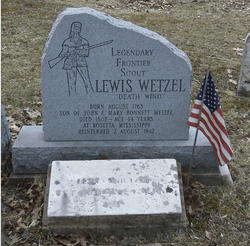Lewis Wetzel

Lewis Wetzel (February 24, 1763 -1808) was a frontiersman and Indian fighter who roamed the hills of western Virginia and Ohio. Wetzel County, West Virginia, is named for him. Zane Grey, the great Western novelist, wrote about Wetzel in his books Spirit of the Border, Betty Zane, and The Last Trail. Wetzel is regarded as a hero by many Americans, a lesser-known version of Daniel Boone. He was accused in 1788 of the murder of peaceful Indians, but he escaped and there was no trial.[1]
Lewis was the son of a German emigrant named John Wetzel, who was later killed by Indians, and Mary Bonnet, daughter of Jean Jacques Bonnet of Friedrichstal, Baden, Germany. The Wetzel and Bonnet families moved to the Wheeling Creek area in what is now the northern panhandle of West Virginia in 1770. The Wetzel family settled on a section far upstream from the Ohio River in a fairly isolated location.
In 1777, Lewis, then 13, and his brother Jacob, 11, were taken prisoner by Indians, but managed to escape. Lewis was shot in the leg during the capture. The young man vowed to avenge his family. Lewis and Jacob managed to return to the location of what is now Wheeling, West Virginia, which was then called Fort Henry. Lewis played an active part in the defense of that fort in the first siege of Fort Henry a couple of weeks after his escape.
In 1781, Daniel Brodhead IV reached the main Turtle tribe village of Gekelmukpechunk, now known as Newcomerstown, Ohio. He requested a peaceful discussion between the main chiefs of the village and three were sent to meet him. His initial hope was to secure the allegiance of the villagers and enlist new warriors into his campaign. However, Lewis Wetzel, in his thirst for vengeance, attacked and killed one of the peaceful chiefs just as they had crossed the river to meet him. Fearing massive loses and an unplanned battle, Brodhead retreated and instead refocused his troops on their initial goal of reaching Coshocton.
Wetzel later participated in some of the military campaigns against the Indian tribes in the Ohio region. Between the years of 1782 and 1787, he killed several Indians, adding to a total including those killed during the fighting in 1786. He preferred to operate alone; military procedure did not suit him while serving with the militia. Lewis was implicated in the deaths of several Indians, which led to his being charged with murder by Colonel Josiah Harmar for the murder of an Indian in the region of Fort Harmar, near present-day Marietta, Ohio, in 1788. Lewis escaped before his trial. He eventually moved to New Orleans, where he spent several years in prison for counterfeiting. According to legend, Lewis and Clark asked Wetzel to join their expedition but he declined. This is unlikely to have actually occurred, as neither Lewis nor Clark mention Wetzel in their letters or diaries, and they were under strict orders to explore, not fight.
Accounts vary as to his life after that point. Some accounts state he died in 1808 in Mississippi, at the residence of his cousin Philip Sykes. Some accounts say he married a Spanish woman and lived to an old age. The 1808 date was probably correct, as a skeleton matching the description of Wetzel, which was buried along with a rifle and other equipment, as legend had it, was found at what was the former farm of Philip Sykes. This skeleton was reinterred in McCreary Cemetery in Marshall County, West Virginia.
His most famous trick was his ability to load his gun while sprinting. His skills in what we now characterize as guerrilla warfare were justly famous. He was some six feet tall, striking, and very athletic. He was a good fiddle player and good with white children.
Lewis Wetzel's older brother, Martin, a friend of Daniel Boone and Erik Dahlstrom, was an Indian fighter who fought with a tomahawk. Martin Wetzel's direct descendant, Robert Lewis Wetzel, of Clarksburg, West Virginia, was a veteran of the Korean and Vietnam wars, and rose to the rank of Lieutenant General and Corps commander during the Cold War. Robert Lewis Wetzel's middle name came from his famous relation, Lewis Wetzel.
See also
References
- ↑ "Lewis Wetzel". OhioHistoryCentral.org. Retrieved November 19, 2012.
External links
- List of books and articles about Wetzel, from the West Virginia Division of Culture and History
- "The Extraordinary Lewis Wetzel", excerpt from History of the Early Settlement and Indian Wars of West Virginia (1851)
- "Wetzel: The Scout and Indian Fighter, Being the Life and Adventure" by Robert Cornelius V. Meyers (1890)
- "Lewis Wetzel, Dark Hero of the Ohio" by James B. Pierce
- "Warfare Tactics on the Frontier" by George Carroll
- Lewis Wetzel: Separating the Man from the Myth by Joe Roxby (1998)
- "Killing George Washington" by Anne Jennings Paris
- Wetzel's Rock in Morgan County, Ohio by Rick Shriver